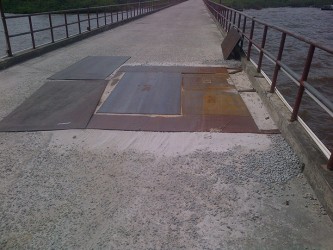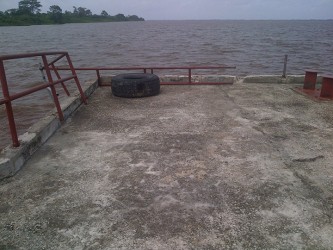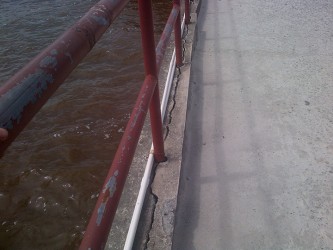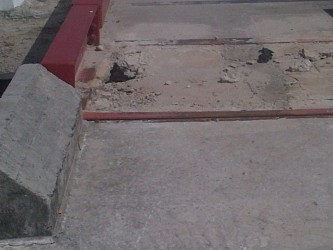The recent collapse of a section of the multi-million dollar Supenaam Stelling is being blamed on neglect, while concerns abound that defects and further wear may exist in other sections of the structure, which could create conditions for an impending calamity.
The stelling has been bedeviled by complications for years and BK International, the contracting company which initially built the structure, has traded blame with the Works Ministry, saying it “messed” up the stelling with the modifications it made.


The stelling was completed to the tune of $431 million but additional works, which cost over $100 million, were eventually needed.
Early in September, a section of the concrete access way to ramps used to board the ferries MV Sabanto and Kanawan gave way under the weight of a city-bound heavy-duty truck carrying several tonnes of rice.
On Sunday, sources told Stabroek News that the collapsed segment of the access way started out as a small hole. But months of neglect and continued use by vehicles, including the heavy-duty trucks, saw the hole grow bigger until it became very unstable and weak, the sources said.
It is believed that hole was caused overtime under the weight of wheels of the heavy-duty trucks as they turned off from the straight section of the pathway to the section where they usually board the ferries.
Both Works Minister Robeson Benn and General Manager of the Transport and Harbours Department Marcelene Merchant reportedly walked past the deteriorated segment of the stelling just one week before the collapse. A source said the minister, accompanied by Merchant, even snapped pictures of the hole, and he argued that faster action could have avoided the collapse just one week after the minister’s visit.
Attempts made to solicit information from Benn and Merchant on the matter were to no avail. Stabroek News also tried to contact BK Head Brian Tiwari but he was not available.
“These people drag they feet. If they had acted faster, this thing cudda never wudda happen,” the source said.


Other parts of the stelling also show some levels of deterioration. The scale used to weigh trucks, although not attached to the stelling itself, is in a very “bad state” and is even broken at the area where the trucks are expected to board. “It has been this way for several months,” one truck driver said, adding that “metal sheets are usually thrown across the broken segment of the scale to allow truck to safely board it.”
Additionally, a part of the railing has been dislodged and now hangs partially over the Essequibo River. The concrete bases, on which of some of the railings are attached to the stelling, have become dislodged in some way, while in other areas, cracks several metres in length were observed running along the base of the rails.
Wooden aspects of the stelling have also deteriorated significantly to the extent that some parts have fallen into the river.
Fear
The situation has affected all of Region Two and especially rice millers and farmers, who depend heavily on the ferry service, which is their only mode of transportation to the capital city, to take their produce to the Georgetown for exportation and distribution to local buyers.
Cars, smaller trucks, other small vehicles and pedestrians were still allowed to use the stelling, by keeping to the right of the access way. Aside from having to exercise caution in staying to the right of the collapsed section of the stelling, it was business as usual for them.
Heavy-duty trucks on the other hand, such as those which transport rice, were slapped with restrictions on the amount of cargo they were allowed to take onto the ferry. The fear, a source explained, was that the weight of the trucks may have caused other sections of the stelling to fall apart as well.
As a result, instead of the13-tonne cargo limit, truck drivers say they were only allowed to take 9 tonnes of rice across on their 7-tonne trucks. While the millers and truck drivers complied with this restriction for a while, it quickly became apparent that the new limit was unacceptable. One truck driver told Stabroek News that it takes two 12-tonne loads of rice to fill a container and the reduced tonnage they were allowed to carry was affecting their operations.
Each truck, carrying the normal tonnage, is usually transporting 12 tonnes or 250 bags of rice per journey. It takes 500 bags or 24 tonnes of rice to fill a container. But the reduction in the allowed tonnage to 9 tonnes (about 160 to 170 bags), the truck drivers say created a situation “that could not work” since instead of 2 trucks filling a container, a third truck-load of rice would be required, bringing an unwanted additional cost. Vehicles desirous of boarding the ferries are charged $1,880 per tonne. Since the trucks are already around seven tonnes, their 12-tonne cargo brings their weight to about 19 tonnes.
‘Patch job’
Frustrations boiled over last week and the truck drivers launched strike action, refusing to board the ferry for several days, until actions were taken to alleviate the situation. Eventually, the collapsed section was patched, but neither the Public Works Ministry nor BK International did the corrective works. Instead, Golden Fleece Rice Investment shouldered the responsibility.
Speaking to Stabroek News on Sunday, Nazeemul Hakh, the company’s Managing Director, said his company did not mind facilitating the works, especially since it would have been helping to better conditions for its own work. The company not only provided the materials with which the gap was patched, but also the workers who carried out the work. Since this time the trucks have been liberated from the restrictions but the delay has already caused financial losses.
The fact that some trucks, despite assembling at the stelling since last Wednesday, were only allowed to cross the river on Friday, also resulted in losses. These trucks and their cargo were forced to spend the weekend in Georgetown, since the customs officers who supervise the loading of containers do not work on weekends.
This reality means that the rice mills had fewer trucks to take their rice to the city—a situation which was expected to change yesterday when the trucks, including the ones which travelled to the city on Sunday, returned to Essequibo.
The repair works came up to about $700,000 and Hakh said that an invoice will be sent to the relevant authority to recover the amounts relating to materials and labour. He is of the opinion that the contractor, who built the structure, is ultimately responsible for the defects and should address them.
In the meantime, he said, since officials are worried that the stelling may not be capable of taking the weight of the heavy-duty trucks, the company has offered to use a barge as an alternative means of accessing the ferries. This would quell weight concerns, but if this is to be done then permission must first be given by the Transport and Harbours Department of the Ministry of Public Works.
This permission has been sought, but has not yet been given, he said.









